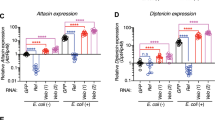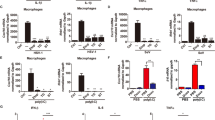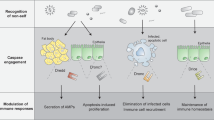Abstract
We have generated, by ethylmethane sulfonate mutagenesis, loss-of-function mutants in the Drosophila homolog of the mammalian I-κB kinase (IKK) complex component IKKγ (also called NEMO). Our data show that Drosophila IKKγ is required for the Relish-dependent immune induction of the genes encoding antibacterial peptides and for resistance to infections by Escherichia coli. However, it is not required for the Toll-DIF–dependent antifungal host defense. The results indicate distinct control mechanisms of the Rel-like transactivators DIF and Relish in the Drosophila innate immune response and show that Drosophila Toll does not signal through a IKKγ-dependent signaling complex. Thus, in contrast to the vertebrate inflammatory response, IKKγ is required for the activation of only one immune signaling pathway in Drosophila.
This is a preview of subscription content, access via your institution
Access options
Subscribe to this journal
Receive 12 print issues and online access
$209.00 per year
only $17.42 per issue
Buy this article
- Purchase on Springer Link
- Instant access to full article PDF
Prices may be subject to local taxes which are calculated during checkout





Similar content being viewed by others
References
Hoffmann, J. A., Kafatos, F. C., Janeway, C. A. & Ezekowitz, R. A. Phylogenetic perspectives in innate immunity. Science 284, 1313–1318 (1999).
Bulet, P., Hetru, C., Dimarcq, J. L. & Hoffmann, D. Antimicrobial peptides in insects; structure and function. Dev. Comp. Immunol. 23, 329–344 (1999).
Ekengren, S. & Hultmark, D. Drosophila cecropin as an antifungal agent. Insect Biochem. Mol. Biol. 29, 965 –972 (1999).
Levashina, E. A. et al. Metchnikowin, a novel immune-inducible proline-rich peptide from Drosophila with antibacterial and antifungal properties. Eur. J. Biochem. 233, 694–700 (1995).
Lowenberger, C. et al. Antimicrobial activity spectrum, cDNA cloning, and mRNA expression of a newly isolated member of the cecropin family from the mosquito vector Aedes aegypti. J. Biol. Chem. 274, 20092 –20097 (1999).
Engström, Y. et al. KappaB-like motifs regulate the induction of immune genes in Drosophila. J. Mol. Biol. 232, 327–333 (1993).
Kappler, C. et al. Insect immunity. Two 17-bp repeats nesting a kappaB-related sequence confer inducibility to the diptericin gene and bind a polypeptide in bacteria-challenged Drosophila. EMBO J. 12 , 1561–1568 (1993).
Meister, M., Braun, A., Kappler, C., Reichhart, J.-M. & Hoffmann, J. A. Insect immunity. A transgenic analysis in Drosophila defines several functional domains in the diptericin promoter. EMBO J. 13, 5958–5966 (1994).
Steward, R. Dorsal, an embryonic polarity gene in Drosophila, is homologous to the vertebrate proto-oncogene, c-rel. Science 238, 692– 694 (1987).
Ip, Y.T. et al. Dif, a dorsal-related gene that mediates an immune-response in Drosophila. Cell 75, 753– 763 (1993).
Dushay, M. S., Asling, B. & Hultmark, D. Origins of immunity: Relish, a compound Rel-like gene in the antibacterial defense of Drosophila. Proc. Natl Acad. Sci. USA 93, 10343–10347 (1996).
Rutschmann, S. et al. The Rel protein DIF mediates the antifungal, but not the antibacterial, response in Drosophila. Immunity 12, 569–580 (2000).
Meng, X., Khanuja, B. S. & Ip, Y. T. Toll receptor-mediated Drosophila immune response requires Dif, an NF- kappaB factor. Genes Dev. 13, 792–797 (1999).
Hedengren, M. et al. Relish, a central factor in the control of humoral but not cellular immunity in Drosophila. Mol. Cell 4, 1–20 (1999).
Govind, S. Control of development and immunity by Rel transcription factors in Drosophila. Oncogene 18, 6875– 6887 (1999).
Manfruelli, P., Reichhart, J. M., Steward, R., Hoffmann, J. A. & Lemaitre, B. A mosaic analysis in Drosophila fat body cells of the control of antimicrobial peptide genes by the Rel proteins Dorsal and DIF. EMBO J. 18, 3380– 3391 (1999).
Tatei, K. & Levine, M. Specificity of Rel-inhibitor interactions in Drosophila embryos. Mol. Cell. Biol. 15, 3627–3634 (1995).
Lemaitre, B., Nicolas, E., Michaut, L., Reichhart, J. M. & Hoffmann, J. A. The dorsoventral regulatory gene cassette spätzle/Toll/cactus controls the potent antifungal response in Drosophila adults. Cell 86, 973–983 (1996).
Nicolas, E., Reichhart, J. M., Hoffmann, J. A. & Lemaitre, B. In vivo regulation of the IkB homologue cactus during the immune response of Drosophila. J. Biol. Chem. 273, 10463–10469 (1998).
Levashina, E. A. et al. Constitutive activation of Toll-mediated antifungal defense in serpin- deficient Drosophila. Science 285 , 1917–1919 (1999).
Stöven, S., Ando, I., Kadalayil, L., Engström, Y. & Hultmark, D. Activation of the Drosophilia NF-κB factor Relish by rapid endoproteolytic cleavage. EMBO R. (in the press, 2000).
Lemaitre, B. et al. A recessive mutation, immune deficiency (imd), defines two distinct control pathways in the Drosophila host defense. Proc. Natl Acad. Sci. USA 92, 9465– 9469 (1995).
Wu, L.P. & Anderson, K. V. Regulated nuclear import of Rel proteins in the Drosophila immune response. Nature 392, 93–97 (1998).
Corbo, J. C. & Levine, M. Characterization of an immunodeficiency mutant in Drosophila. Mech. Dev. 55, 211 –220 (1996).
Levashina, E. A., Ohresser, S., Lemaitre, B. & Imler, J. L. Two distinct pathways can control expression of the gene encoding the Drosophila antimicrobial peptide metchnikowin. J. Mol. Biol. 278 , 515–527 (1998).
Lemaitre, B., Reichhart, J. M. & Hoffmann, J. A. Drosophila host defense: differential display of antimicrobial peptide genes after infection by various classes of microorganisms . Proc. Natl Acad. Sci. USA 94, 14614– 14619 (1997).
Flyg, C. & Boman, H. G. Drosophila genes cut and miniature are associated with the susceptibility to infection by Serratia marcessens. Genet. Res. 52, 51–56 (1988).
Cohen, S. M., Bronner, G., Kuttner, F., Jurgens, G. & Jackle, H. Distal-less encodes a homoeodomain protein required for limb development in Drosophila. Nature 338, 432–434 (1989).
Silverman, N. et al. A Drosophila I-B kinase complex required for Relish cleavage and antibacterial immunity. Genes Dev., in press (2000).
Yamaoka, S. et al. Complementation cloning of NEMO, a component of the IkappaB kinase complex essential for NF-kappaB activation. Cell 93, 1231–1240 (1998).
Rothwarf, D. M., Zandi, E., Natoli, G. & Karin, M. IKK-gamma is an essential regulatory subunit of the IkappaB kinase complex. Nature 395, 297–300 (1998).
Mercurio, F. et al. IkappaB kinase (IKK)-associated protein 1, a common component of the heterogeneous IKK complex. Mol. Cell. Biol. 19, 1526–1538 (1999).
Li, Y. et al. Identification of a cell protein (FIP-3) as a modulator of NF-kappaB activity and as a target of an adenovirus inhibitor of tumor necrosis factor alpha-induced apoptosis. Proc. Natl Acad. Sci. USA 96, 1042–1047 (1999).
Zhang, S. Q., Kovalenko, A., Cantarella, G. & Wallach, D. Recruitment of the IKK signalosome to the p55 TNF receptor: RIP and A20 bind to NEMO (IKKgamma) upon receptor stimulation. Immunity 12, 301–311 (2000).
Israël, A. The IKK complex: an integrator of all signals that affect NF-kappaB. Trends Cell Biol. 10, 129–133 (2000).
Smahi, A. et al. Genomic rearrangement in NEMO impairs NF-kappaB activation and is a cause of incontinentia pigmenti. The International Incontinentia Pigmenti (IP) Consortium. Nature 405, 466– 472 (2000).
Rudolph, D. et al. Severe liver degeneration and lack of NF-kappaB activation in NEMO/IKKgamma-deficient mice. Genes Dev. 14, 854–862 (2000).
Schmidt-Supprian, M. et al. NEMO/IKKγ-deficient mice model Incontinentia Pigmenti . Mol. Cell 5, 981–992 (2000).
Makris, C. et al. Female mice heterozygous for IKKγ/NEMO deficiencies develop a dermatopathy similar to the human X-linked disorder Incontinentia Pigmenti. Mol. Cell 5, 969– 979 (2000).
Peters, R.T., Liao, S.-M. & Maniatis, T. IKK epsilon is part of a novel PMA-inducible I-kappaB kinase complex. Mol. Cell 5, 513– 522 (2000).
Pomerantz, J. L. & Baltimore, D. NF-kappaB activation by a signaling complex containing TRAF2, TANK and TBK1, a novel IKK-related kinase. EMBO J. 18, 6694– 6704 (1999).
Tojima, Y. et al. NAK is an IkappaB kinase-activating kinase. Nature 404, 778–782 (2000).
Lu, Y., Wu, L. & Anderson, K. Molecular and genetic analysis of ird5 gene. 40th Annual Drosophila Research Conference 143 (Seattle, 1999).
Kim, Y. S. et al. Lipopolysaccharide-activated kinase, an essential component for the induction of the antimicrobial peptide genes in Drosophila melanogaster cells. J. Biol. Chem. 275, 2071– 2079 (2000).
Williams, M., Rodriguez, A., Kimbrell, D. & Eldon, E. The 18-wheeler mutation reveals complex antibacterial gene regulation in Drosophila host defense. EMBO J. 15, 6120– 6130 (1997).
Leulier, F., Rodriguez, A., Khush, R. S., Abrams, J. M. & Lemaitre, B. The Drosophila caspase Dredd is required to resist Gram-negative bacterial infections. EMBO R. (in the press, 2000).
Elrod-Erickson, M., Mishra, S. & Schneider, D. Interactions between the cellular and humoral immune responses in Drosophila. Curr. Biol. 10781– 10784 (2000).
Lemaitre, B. et al. Functional analysis and regulation of nuclear import of dorsal during the immune response in Drosophila. EMBO J. 14, 536–545 (1995).
Lupas, A., Van Dyke, M. & Stock, J. Predicting coiled coils from protein sequences. Science 252, 1162–1164 (1991).
Acknowledgements
We thank D. Hultmark for Relish fly stocks; E. Langley and M.-C. Criqui for the DIF antibody; M.-C. Criqui for participating in initial phases of the screen; C. Troccon, S. Storck and S. Dissel for help with the screen; P. Georgel for help with gel retardation assays; R. Lanot for phagocytosis assays; and J.-M. Reichhart and T. Maniatis for their interest and support. Supported by CNRS, the Human Frontiers in Science Program (to J. H.), the Helen Hey Whitney Foundation (to N. S.), NIH grants (GM29379, GM59919 to T. Maniatis; 1PO1 AI44220-02 to A. Ezekowitz and J. H.), the French Ministère de l'Education Nationale, de la Recherche et de la Technologie (PRFMMIP) and the Fondation pour la Recherche Médicale (aide à l'implantation de nouvelles équipes to D. F).
Author information
Authors and Affiliations
Corresponding author
Rights and permissions
About this article
Cite this article
Rutschmann, S., Jung, A., Zhou, R. et al. Role of Drosophila IKKγ in a Toll-independent antibacterial immune response. Nat Immunol 1, 342–347 (2000). https://doi.org/10.1038/79801
Received:
Accepted:
Issue Date:
DOI: https://doi.org/10.1038/79801
This article is cited by
-
Drosophila caspases as guardians of host-microbe interactions
Cell Death & Differentiation (2023)
-
Sensing microbial infections in the Drosophila melanogaster genetic model organism
Immunogenetics (2022)
-
Sex-specific responses to cold in a very cold-tolerant, northern Drosophila species
Heredity (2021)
-
Verloren negatively regulates the expression of IMD pathway dependent antimicrobial peptides in Drosophila
Scientific Reports (2021)
-
Kenny mediates selective autophagic degradation of the IKK complex to control innate immune responses
Nature Communications (2017)



